warning light Lancia Musa 2011 Owner handbook (in English)
[x] Cancel search | Manufacturer: LANCIA, Model Year: 2011, Model line: Musa, Model: Lancia Musa 2011Pages: 218, PDF Size: 3.91 MB
Page 116 of 218
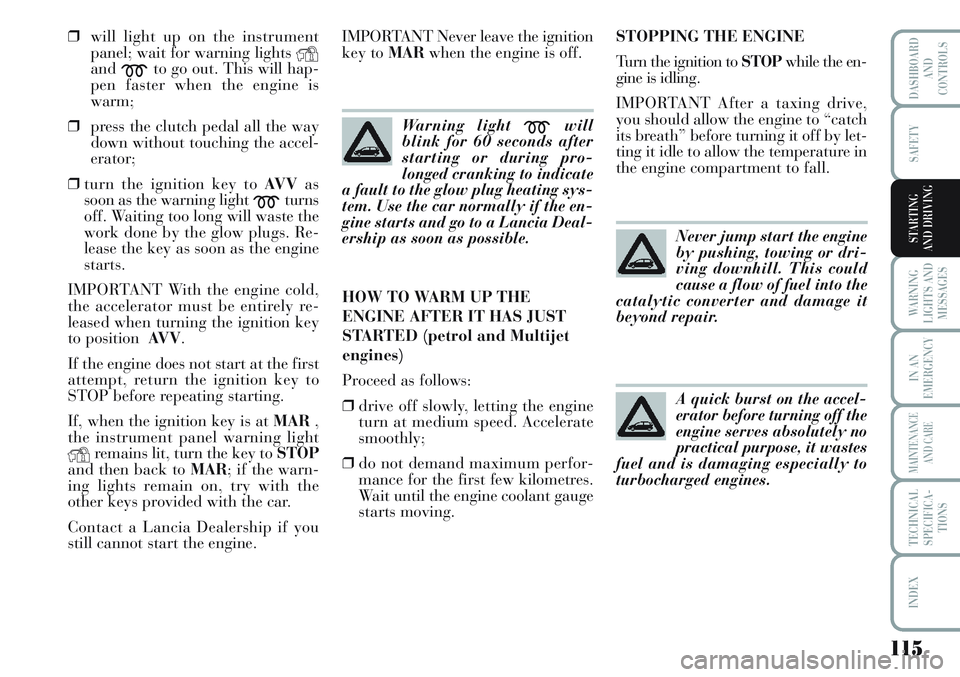
115
WARNING
LIGHTS AND
MESSAGES
IN AN
EMERGENCY
MAINTENANCE
AND CARE
TECHNICAL
SPECIFICA-
TIONS
INDEX
DASHBOARD
AND
CONTROLS
SAFETY
STARTING
AND DRIVING
❒will light up on the instrument
panel; wait for warning lights
Yand
mto go out. This will hap-
pen faster when the engine is
warm;
❒press the clutch pedal all the way
down without touching the accel-
erator;
❒turn the ignition key to AV Vas
soon as the warning light
mturns
off. Waiting too long will waste the
work done by the glow plugs. Re-
lease the key as soon as the engine
starts.
IMPORTANT With the engine cold,
the accelerator must be entirely re-
leased when turning the ignition key
to position AV V.
If the engine does not start at the first
attempt, return the ignition key to
STOP before repeating starting.
If, when the ignition key is at MAR,
the instrument panel warning light
Yremains lit, turn the key to STOP
and then back to MAR; if the warn-
ing lights remain on, try with the
other keys provided with the car.
Contact a Lancia Dealership if you
still cannot start the engine.HOW TO WARM UP THE
ENGINE AFTER IT HAS JUST
STARTED (petrol and Multijet
engines)
Proceed as follows:
❒drive off slowly, letting the engine
turn at medium speed. Accelerate
smoothly;
❒do not demand maximum perfor-
mance for the first few kilometres.
Wait until the engine coolant gauge
starts moving.Warning light
mwill
blink for 60 seconds after
starting or during pro-
longed cranking to indicate
a fault to the glow plug heating sys-
tem. Use the car normally if the en-
gine starts and go to a Lancia Deal-
ership as soon as possible.
STOPPING THE ENGINE
Turn the ignition to STOPwhile the en-
gine is idling.
IMPORTANT After a taxing drive,
you should allow the engine to “catch
its breath” before turning it off by let-
ting it idle to allow the temperature in
the engine compartment to fall.
Never jump start the engine
by pushing, towing or dri-
ving downhill. This could
cause a flow of fuel into the
catalytic converter and damage it
beyond repair.
A quick burst on the accel-
erator before turning off the
engine serves absolutely no
practical purpose, it wastes
fuel and is damaging especially to
turbocharged engines.
IMPORTANT Never leave the ignition
key to MARwhen the engine is off.
Page 117 of 218
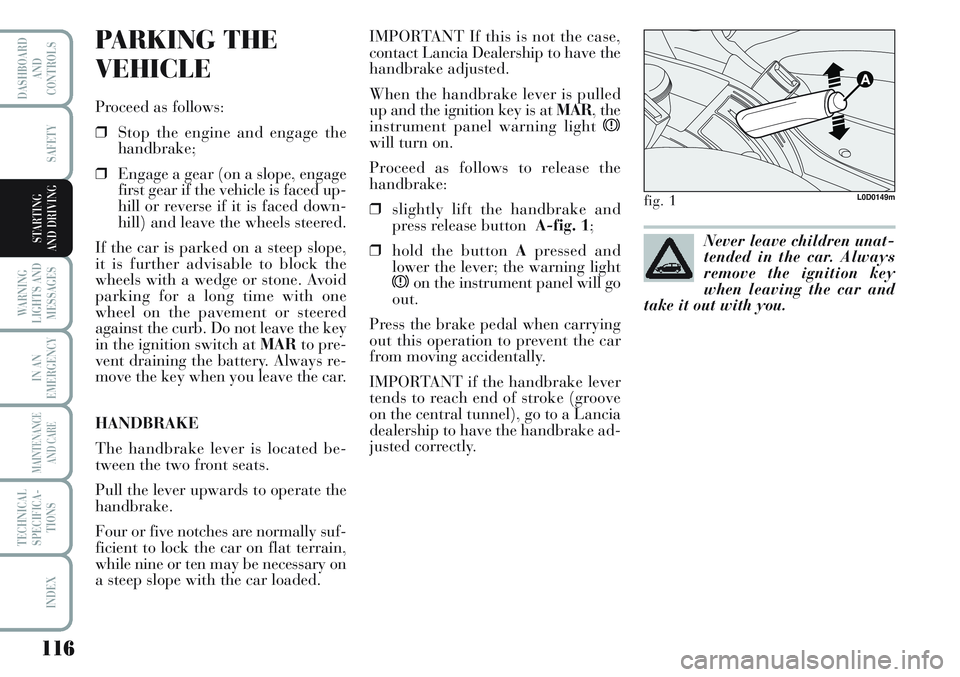
116
WARNING
LIGHTS AND
MESSAGES
IN AN
EMERGENCY
MAINTENANCE
AND CARE
TECHNICAL
SPECIFICA-
TIONS
INDEX
DASHBOARD
AND
CONTROLS
SAFETY
STARTING
AND DRIVING
PARKING THE
VEHICLE
Proceed as follows:
❒Stop the engine and engage the
handbrake;
❒Engage a gear (on a slope, engage
first gear if the vehicle is faced up-
hill or reverse if it is faced down-
hill) and leave the wheels steered.
If the car is parked on a steep slope,
it is further advisable to block the
wheels with a wedge or stone. Avoid
parking for a long time with one
wheel on the pavement or steered
against the curb. Do not leave the key
in the ignition switch at MARto pre-
vent draining the battery. Always re-
move the key when you leave the car.
HANDBRAKE
The handbrake lever is located be-
tween the two front seats.
Pull the lever upwards to operate the
handbrake.
Four or five notches are normally suf-
ficient to lock the car on flat terrain,
while nine or ten may be necessary on
a steep slope with the car loaded. IMPORTANT If this is not the case,
contact Lancia Dealership to have the
handbrake adjusted.
When the handbrake lever is pulled
up and the ignition key is at MAR, the
instrument panel warning light
xwill turn on.
Proceed as follows to release the
handbrake:
❒slightly lift the handbrake and
press release button A-fig. 1;
❒hold the button Apressed and
lower the lever; the warning light
xon the instrument panel will go
out.
Press the brake pedal when carrying
out this operation to prevent the car
from moving accidentally.
IMPORTANT if the handbrake lever
tends to reach end of stroke (groove
on the central tunnel), go to a Lancia
dealership to have the handbrake ad-
justed correctly.
fig. 1L0D0149m
Never leave children unat-
tended in the car. Always
remove the ignition key
when leaving the car and
take it out with you.
Page 118 of 218
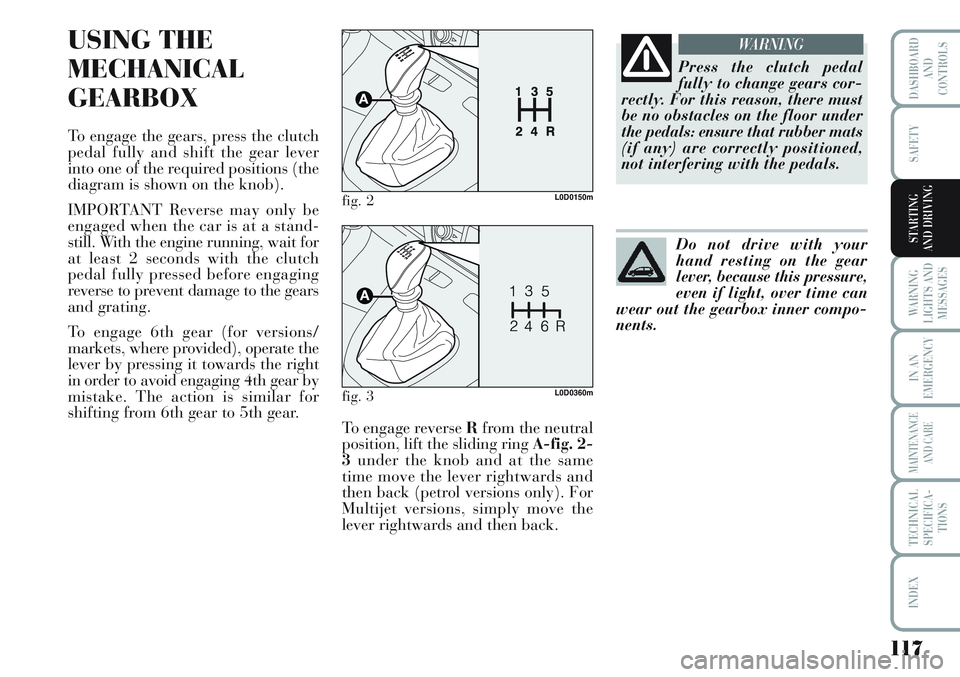
117
WARNING
LIGHTS AND
MESSAGES
IN AN
EMERGENCY
MAINTENANCE
AND CARE
TECHNICAL
SPECIFICA-
TIONS
INDEX
DASHBOARD
AND
CONTROLS
SAFETY
STARTING
AND DRIVING
USING THE
MECHANICAL
GEARBOX
To engage the gears, press the clutch
pedal fully and shift the gear lever
into one of the required positions (the
diagram is shown on the knob).
IMPORTANT Reverse may only be
engaged when the car is at a stand-
still. With the engine running, wait for
at least 2 seconds with the clutch
pedal fully pressed before engaging
reverse to prevent damage to the gears
and grating.
To engage 6th gear (for versions/
markets, where provided), operate the
lever by pressing it towards the right
in order to avoid engaging 4th gear by
mistake. The action is similar for
shifting from 6th gear to 5th gear.
To engage reverse Rfrom the neutral
position, lift the sliding ring A-fig. 2-
3under the knob and at the same
time move the lever rightwards and
then back (petrol versions only). For
Multijet versions, simply move the
lever rightwards and then back.
fig. 2L0D0150m
fig. 3L0D0360m
Do not drive with your
hand resting on the gear
lever, because this pressure,
even if light, over time can
wear out the gearbox inner compo-
nents.
Press the clutch pedal
fully to change gears cor-
rectly. For this reason, there must
be no obstacles on the floor under
the pedals: ensure that rubber mats
(if any) are correctly positioned,
not interfering with the pedals.
WARNING
Page 119 of 218
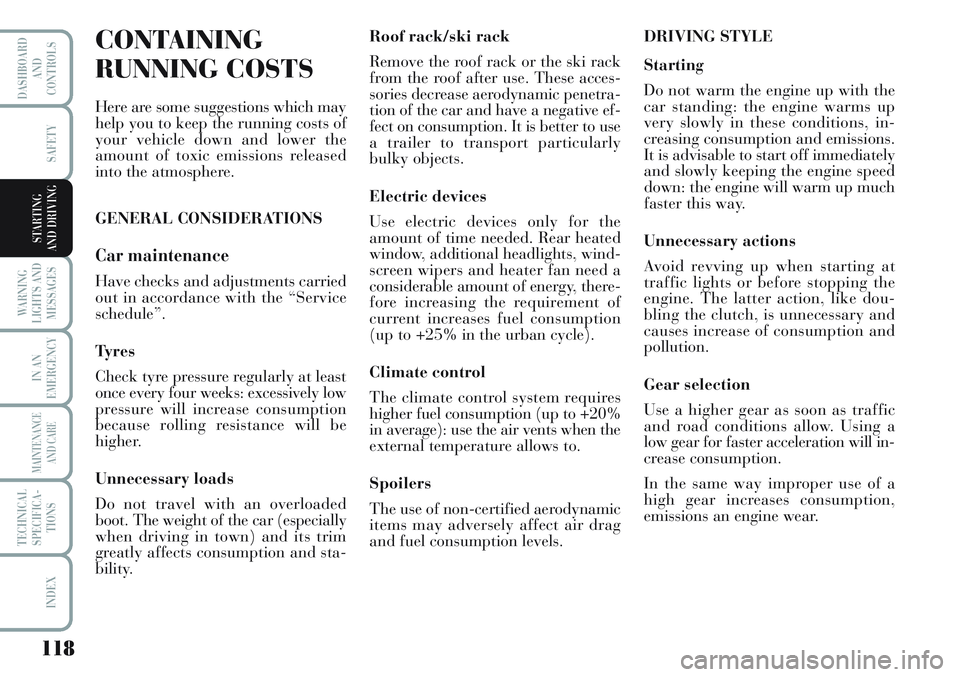
118
WARNING
LIGHTS AND
MESSAGES
IN AN
EMERGENCY
MAINTENANCE
AND CARE
TECHNICAL
SPECIFICA-
TIONS
INDEX
DASHBOARD
AND
CONTROLS
SAFETY
STARTING
AND DRIVING
CONTAINING
RUNNING COSTS
Here are some suggestions which may
help you to keep the running costs of
your vehicle down and lower the
amount of toxic emissions released
into the atmosphere.
GENERAL CONSIDERATIONS
Car maintenance
Have checks and adjustments carried
out in accordance with the “Service
schedule”.
Ty r e s
Check tyre pressure regularly at least
once every four weeks: excessively low
pressure will increase consumption
because rolling resistance will be
higher.
Unnecessary loads
Do not travel with an overloaded
boot. The weight of the car (especially
when driving in town) and its trim
greatly affects consumption and sta-
bility.Roof rack/ski rack
Remove the roof rack or the ski rack
from the roof after use. These acces-
sories decrease aerodynamic penetra-
tion of the car and have a negative ef-
fect on consumption. It is better to use
a trailer to transport particularly
bulky objects.
Electric devices
Use electric devices only for the
amount of time needed. Rear heated
window, additional headlights, wind-
screen wipers and heater fan need a
considerable amount of energy, there-
fore increasing the requirement of
current increases fuel consumption
(up to +25% in the urban cycle).
Climate control
The climate control system requires
higher fuel consumption (up to +20%
in average): use the air vents when the
external temperature allows to.
Spoilers
The use of non-certified aerodynamic
items may adversely affect air drag
and fuel consumption levels.DRIVING STYLE
Starting
Do not warm the engine up with the
car standing: the engine warms up
very slowly in these conditions, in-
creasing consumption and emissions.
It is advisable to start off immediately
and slowly keeping the engine speed
down: the engine will warm up much
faster this way.
Unnecessary actions
Avoid revving up when starting at
traffic lights or before stopping the
engine. The latter action, like dou-
bling the clutch, is unnecessary and
causes increase of consumption and
pollution.
Gear selection
Use a higher gear as soon as traffic
and road conditions allow. Using a
low gear for faster acceleration will in-
crease consumption.
In the same way improper use of a
high gear increases consumption,
emissions an engine wear.
Page 120 of 218
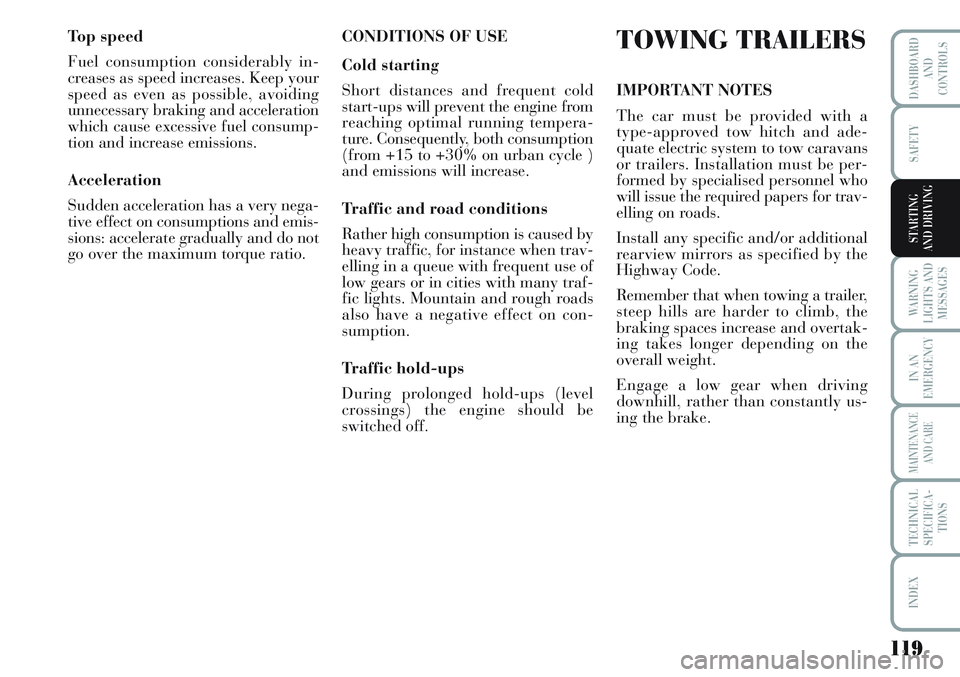
119
WARNING
LIGHTS AND
MESSAGES
IN AN
EMERGENCY
MAINTENANCE
AND CARE
TECHNICAL
SPECIFICA-
TIONS
INDEX
DASHBOARD
AND
CONTROLS
SAFETY
STARTING
AND DRIVING
Top speed
Fuel consumption considerably in-
creases as speed increases. Keep your
speed as even as possible, avoiding
unnecessary braking and acceleration
which cause excessive fuel consump-
tion and increase emissions.
Acceleration
Sudden acceleration has a very nega-
tive effect on consumptions and emis-
sions: accelerate gradually and do not
go over the maximum torque ratio.CONDITIONS OF USE
Cold starting
Short distances and frequent cold
start-ups will prevent the engine from
reaching optimal running tempera-
ture. Consequently, both consumption
(from +15 to +30% on urban cycle )
and emissions will increase.
Traffic and road conditions
Rather high consumption is caused by
heavy traffic, for instance when trav-
elling in a queue with frequent use of
low gears or in cities with many traf-
fic lights. Mountain and rough roads
also have a negative effect on con-
sumption.
Traffic hold-ups
During prolonged hold-ups (level
crossings) the engine should be
switched off.TOWING TRAILERS
IMPORTANT NOTES
The car must be provided with a
type-approved tow hitch and ade-
quate electric system to tow caravans
or trailers. Installation must be per-
formed by specialised personnel who
will issue the required papers for trav-
elling on roads.
Install any specific and/or additional
rearview mirrors as specified by the
Highway Code.
Remember that when towing a trailer,
steep hills are harder to climb, the
braking spaces increase and overtak-
ing takes longer depending on the
overall weight.
Engage a low gear when driving
downhill, rather than constantly us-
ing the brake.
Page 121 of 218
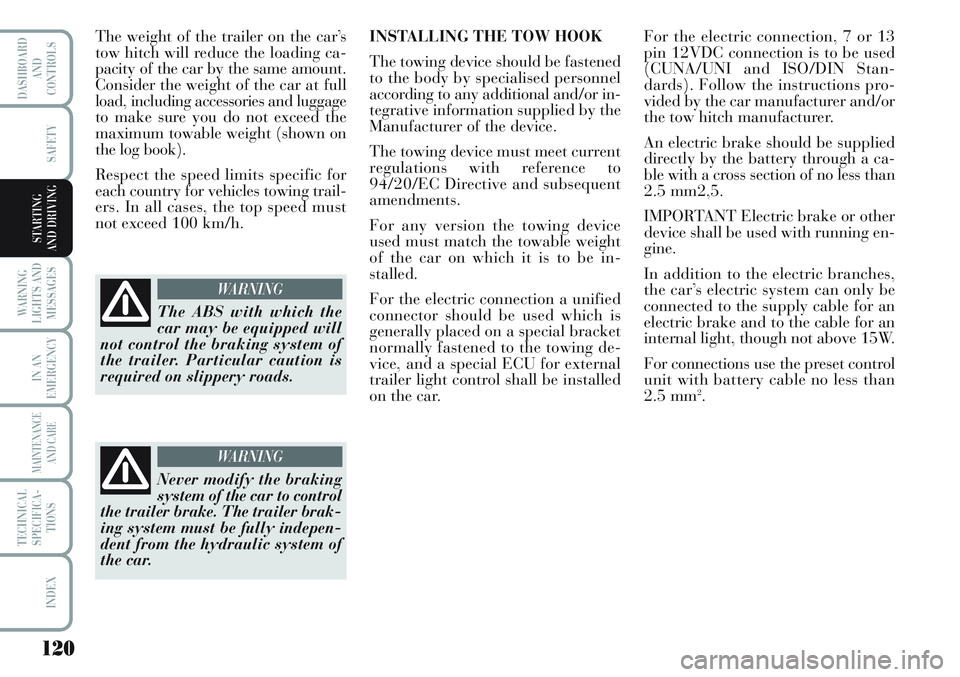
120
WARNING
LIGHTS AND
MESSAGES
IN AN
EMERGENCY
MAINTENANCE
AND CARE
TECHNICAL
SPECIFICA-
TIONS
INDEX
DASHBOARD
AND
CONTROLS
SAFETY
STARTING
AND DRIVING
The weight of the trailer on the car’s
tow hitch will reduce the loading ca-
pacity of the car by the same amount.
Consider the weight of the car at full
load, including accessories and luggage
to make sure you do not exceed the
maximum towable weight (shown on
the log book).
Respect the speed limits specific for
each country for vehicles towing trail-
ers. In all cases, the top speed must
not exceed 100 km/h.
The ABS with which the
car may be equipped will
not control the braking system of
the trailer. Particular caution is
required on slippery roads.
WARNING
Never modify the braking
system of the car to control
the trailer brake. The trailer brak-
ing system must be fully indepen-
dent from the hydraulic system of
the car.
WARNING
INSTALLING THE TOW HOOK
The towing device should be fastened
to the body by specialised personnel
according to any additional and/or in-
tegrative information supplied by the
Manufacturer of the device.
The towing device must meet current
regulations with reference to
94/20/EC Directive and subsequent
amendments.
For any version the towing device
used must match the towable weight
of the car on which it is to be in-
stalled.
For the electric connection a unified
connector should be used which is
generally placed on a special bracket
normally fastened to the towing de-
vice, and a special ECU for external
trailer light control shall be installed
on the car. For the electric connection, 7 or 13
pin 12VDC connection is to be used
(CUNA/UNI and ISO/DIN Stan-
dards). Follow the instructions pro-
vided by the car manufacturer and/or
the tow hitch manufacturer.
An electric brake should be supplied
directly by the battery through a ca-
ble with a cross section of no less than
2.5 mm2,5.
IMPORTANT Electric brake or other
device shall be used with running en-
gine.
In addition to the electric branches,
the car’s electric system can only be
connected to the supply cable for an
electric brake and to the cable for an
internal light, though not above 15W.
For connections use the preset control
unit with battery cable no less than
2.5 mm
2.
Page 122 of 218

121
WARNING
LIGHTS AND
MESSAGES
IN AN
EMERGENCY
MAINTENANCE
AND CARE
TECHNICAL
SPECIFICA-
TIONS
INDEX
DASHBOARD
AND
CONTROLS
SAFETY
STARTING
AND DRIVING
holes
load Existing
Standard ball
fig. 4
ASSEMBLY DIAGRAM fig. 4
The tow hook structure must be fastened in the points
shown by the symbol
Øusing a total of 4 M8 screws, 2
M10 screws and 2 M12 screws.
The hook should be fastened to the body avoiding any
type of drilling and trimming of the rear bumpers that re-
mains visible when the hook is removed.
IMPORTANT It is compulsory to fasten a label (plainly
visible) of suitable size and material with the following
wording:
MAX LOAD ON BALL 60 kg
After fitting, screw holes shall be sealed to
prevent exhaust gas inlet.
WARNING
L0D0256m
> 318 ± 5
Page 123 of 218

122
WARNING
LIGHTS AND
MESSAGES
IN AN
EMERGENCY
MAINTENANCE
AND CARE
TECHNICAL
SPECIFICA-
TIONS
INDEX
DASHBOARD
AND
CONTROLS
SAFETY
STARTING
AND DRIVING
SNOW TYRES
Use snow tyres of the same size as the
normal tyres provided with the car.
Lancia Dealership will be happy to
provide advice concerning the most
suitable type of tyre for the customer’s
requirements.
For the type of tyre to be used, infla-
tion pressures and the specifications
of snow tyres, follow the instructions
given in paragraph “Wheels” in sec-
tion “Technical specifications”.
The performance of these tyres is con-
siderably reduced when the tread
depth is less than 4 mm. Replace
them in this case.Due to their specific features, the per-
formance of snow tyres is much lower
than that of normal types in normal
conditions or long motorway
stretches. Limit performance accord-
ing the use for which they were ap-
proved.
IMPORTANT When snow tyres are
used with a max speed index below
the one that can be reached by the car
(increased by 5%), place a notice in
the passenger’s compartment, plainly
in the driver’s view which states the
max permissible speed of the snow
tyres (as per EC Directive).
All four tyres should be the same
(brand and track) to ensure greater
safety when driving and braking and
better driveability.
Remember that it is inappropriate to
change the direction of rotation of
tyres.The top speed of a “T”
type snow tyre is 190
km/h. Respect the highway code in
all cases.
WARNING
Page 124 of 218
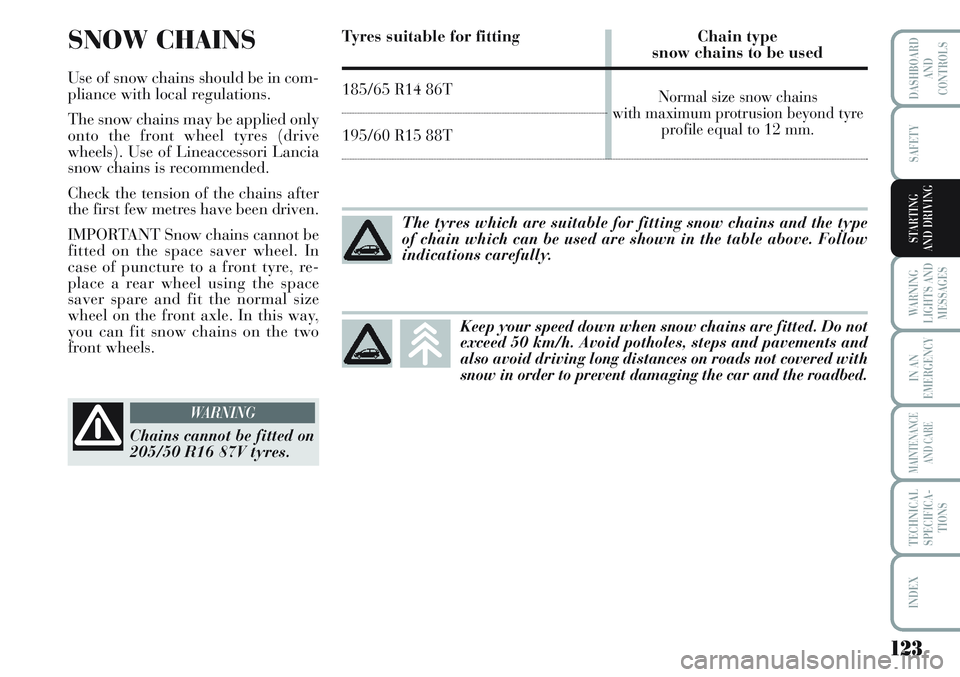
123
WARNING
LIGHTS AND
MESSAGES
IN AN
EMERGENCY
MAINTENANCE
AND CARE
TECHNICAL
SPECIFICA-
TIONS
INDEX
DASHBOARD
AND
CONTROLS
SAFETY
STARTING
AND DRIVING
SNOW CHAINS
Use of snow chains should be in com-
pliance with local regulations.
The snow chains may be applied only
onto the front wheel tyres (drive
wheels). Use of Lineaccessori Lancia
snow chains is recommended.
Check the tension of the chains after
the first few metres have been driven.
IMPORTANT Snow chains cannot be
fitted on the space saver wheel. In
case of puncture to a front tyre, re-
place a rear wheel using the space
saver spare and fit the normal size
wheel on the front axle. In this way,
you can fit snow chains on the two
front wheels.
The tyres which are suitable for fitting snow chains and the type
of chain which can be used are shown in the table above. Follow
indications carefully.
Keep your speed down when snow chains are fitted. Do not
exceed 50 km/h. Avoid potholes, steps and pavements and
also avoid driving long distances on roads not covered with
snow in order to prevent damaging the car and the roadbed.
Tyres suitable for fitting Chain typesnow chains to be used
185/65 R14 86T
195/60 R15 88T
Chains cannot be fitted on
205/50 R16 87V tyres.
WARNING
Normal size snow chains
with maximum protrusion beyond tyre
profile equal to 12 mm.
Page 125 of 218
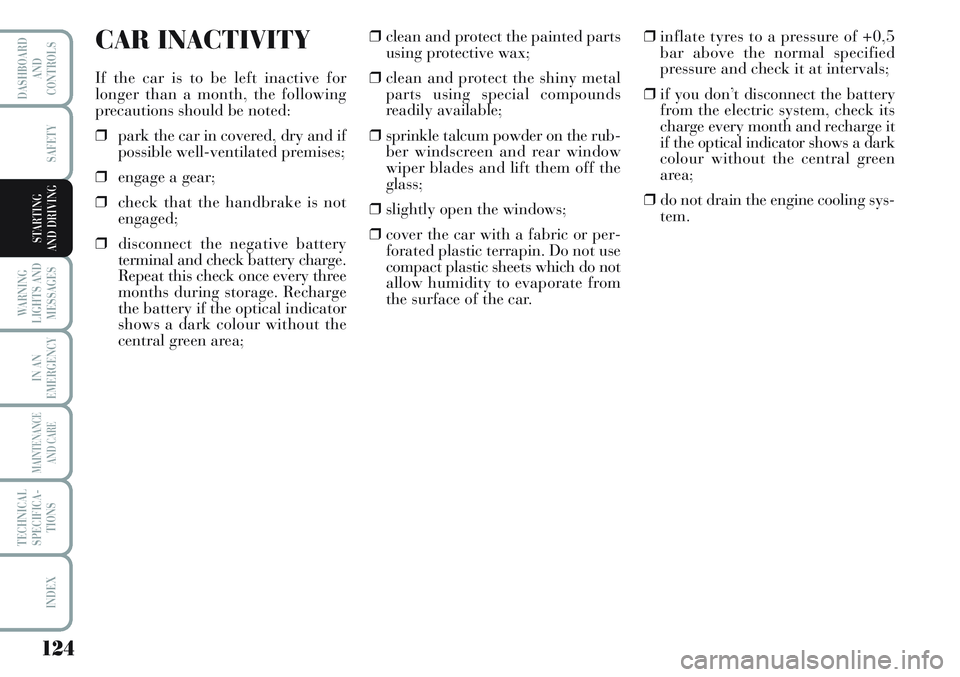
124
WARNING
LIGHTS AND
MESSAGES
IN AN
EMERGENCY
MAINTENANCE
AND CARE
TECHNICAL
SPECIFICA-
TIONS
INDEX
DASHBOARD
AND
CONTROLS
SAFETY
STARTING
AND DRIVING
CAR INACTIVITY
If the car is to be left inactive for
longer than a month, the following
precautions should be noted:
❒park the car in covered, dry and if
possible well-ventilated premises;
❒engage a gear;
❒check that the handbrake is not
engaged;
❒disconnect the negative battery
terminal and check battery charge.
Repeat this check once every three
months during storage. Recharge
the battery if the optical indicator
shows a dark colour without the
central green area;❒clean and protect the painted parts
using protective wax;
❒clean and protect the shiny metal
parts using special compounds
readily available;
❒sprinkle talcum powder on the rub-
ber windscreen and rear window
wiper blades and lift them off the
glass;
❒slightly open the windows;
❒cover the car with a fabric or per-
forated plastic terrapin. Do not use
compact plastic sheets which do not
allow humidity to evaporate from
the surface of the car.❒inflate tyres to a pressure of +0,5
bar above the normal specified
pressure and check it at intervals;
❒if you don’t disconnect the battery
from the electric system, check its
charge every month and recharge it
if the optical indicator shows a dark
colour without the central green
area;
❒do not drain the engine cooling sys-
tem.